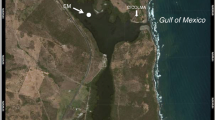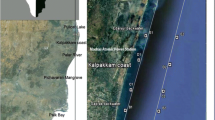Abstract
A mesocosm experiment was used to investigate the effect of terrestrial-origin dissolved organic matter (DOM) on the development of dinoflagellates in natural summer phytoplankton from the Gulf of Riga. Seawater was collected in the central part of the Gulf of Riga and at the entrance of the Gulf in June 1999. DOM was extracted from Pärnu River water by use of tangential ultrafiltration. Experimental series were enriched with DOM, DOM in combination with nitrate and phosphate, and only with inorganic nutrients. Enrichments were added in ranges of their natural concentrations. Dinophysis acuminata, Protoperidinium brevipes and Gymnodinium spp. were dominant species in the initial dinoflagellate community. During the experiment, the best growth of dinoflagellates was observed in treatments with DOM and DOM in combination with phosphate, mainly due to active growth of D. acuminata (maximum μ=0.8 day−1). Significant uptake of dissolved organic nitrogenous compounds was seen, indicating the importance of heterotrophic nutrition among the phytoplankton species.
Similar content being viewed by others
References
Agusti, S. & J. Kalff, 1989. The influence of growth conditions on the size dependence of maximal algal density and biomass. Limnol. Oceanogr. 34: 1104–1108.
Andrushaitis, A., Z. Seisuma, M. Legzdina & E. Lensh, 1995. River load of eutrophying substances and heavy metals into the Gulf of Riga. In Ojaveer, E. (ed.), Ecosystem of the Gulf of Riga between 1920 and 1990. Estonian Academy Publishers, Tallinn. Academia 5: 32–40.
Azam, F., T. Fenchel, J. G. Field, J. S. Gray, L. A. Meyer-Reil & F. Thingstadt, 1983. The ecological role of water column microbes in the sea. Mar. Ecol. Prog. Ser. 10: 257–273.
Balode, M., 1994. Long-term changes of summer-autumn phytoplankton communities in the Gulf of Riga. In Guelorget, O. & A. Lefebvre (eds), A Comparative Ecological Approach of Coastal Environments and Paralic Ecosystems, Proceedings of the International Congress of the Baltic See and Mediterranean Sea, 30 May-3 June 1994, Montpellier, France: 96–99.
Balode, M. & I. Purina, 1996. Harmful phytoplankton in the Gulf of Riga (the Baltic Sea). In Yasumoto, T., Y. Oshima & Y. Fukuyo (eds), Harmful and Toxic Algal Blooms, Intergovernmental Oceanographic Commission of UNESCO: 69-72.
Balode, M., I. Purina, C. Bechemin & S. Y. Maestrini, 1998. Effects of nutrient enrichment on the growth rates and community structure of summer phytoplankton from the Gulf of Riga, Baltic Sea. J. Plankton Res. 20: 2251–2272.
Barlewska, J. M. & Z. Witek, 1995. Heterotrophic dinoflagellates in the ecosystem of the Gulf of Gdansk. Mar. Ecol. Prog. Ser. 117: 241–248.
Benner, R., B. Biddanda, B. Black & M. McCarthy, 1997. Abundance, size distribution, and stable carbon and nitrogen isotopic compositions of marine organic matter isolated by tangential flow ultra-filtration. Mar. Chem. 57: 243–263.
Berg, G. M., P. M. Glibert, N. O. G. Jorgensen, M. Balode & I. Purina, 2001. Variability in inorganic and organic nitrogen uptake associated with riverine input in the Gulf of Riga, Baltic Sea. Estuaries 24: 204–212.
Berland, B. R., S. Y. Maestrini, C. Bechemin & C. Legrand, 1994. Photosynthetic capacity of the toxic dinoflagellates Dinophysis cf. acuminata and Dinophysis acuta. La Mer 32: 107–117.
Berman, T., C. Bechemin & S. Y. Maestrini, 1999. Release of ammonium and urea from dissolved organic nitrogen in aquatic ecosystems. Aquat. Microb. Ecol. 16: 295–302.
Carlsson, P., E. Granéli & A. Z. Segatto, 1999. Cycling of biologically available nitrogen in riverine humic substances between marine bacteria, a heterotrophic nanoflagellate and a photosynthetic dinoflagellate. Aquat. Microb. Ecol. 18: 23–36.
Carlsson, P., E. Granéli, P. A. Tester & L. Boni, 1995. Influences of riverine humic substances on bacteria, protozoa, phytoplankton, and copepods in a coastal plankton community. Mar. Ecol. Prog. Ser. 127: 213–221.
Carlsson, P., A. Z. Segatto & E. Granéli,1993. Nitrogen bound to humic matter of terrestrial origin-a nitrogen pool for coastal phytoplankton? Mar. Ecol. Prog. Ser. 97: 105–116.
Chang, F. H. & M. McClean, 1997. Growth responses of Alexandrium minutum (Dinophyceae) as a function of three different nitrogen sources and irradiance. New Zeal. J. Mar. Freshwat. Res. 31: 1–7.
Doblin, M. A., S. I. Blackburn & G. M. Hallegraeff, 1999. Growth and biomass stimulation of the toxic dinoflagellate Gymnodinium catenatum (Graham) by dissolved organic substances. J. Exp. Mar. Biol. Ecol. 236: 33–47.
Edler, L., (ed.), 1979. Recommendations on the methods for marine biological studies in the Baltic Sea phytoplankton and chlorophyll. Dept. of Marine Botany, University of Lund, Lund. Publications of the Baltic Marine Biologists 5: 1-38.
Gaines, G. & M. Elbrachter, 1987. Heterotrophic nutrition. In Taylor, F. J. (ed.), The Biology of Dinoflagellates. Blackwell, Oxford: 224–268.
Garces, E. & M. Maso, 2001. Phytoplankton potential growth rates versus increase in cell numbers: estimation of cell lysis. Mar. Ecol. Prog. Ser. 212: 297–300.
Granéli, E., D. M. Anderson, P. Carlsson & S. Y. Maestrini, 1997. Light and dark carbon uptake by Dinophysis species in comparison to other photosynthetic and heterotrophic dinoflagellates. Aquat. Microb. Ecol. 13: 177–186.
Granéli, E. & P. Carlsson, 1998. The ecological significance of phagotrophy in photosynthetic flagellates. In Anderson, D. M., A. D. Cembella & G. M. Hallegraeff (eds), Physiological Ecology of Harmful Algal Blooms, Springer-Verlag, Berlin: 539–557.
Granéli, E., P. Carlsson & C. Legrand, 1999. The role of C, N and P in dissolved and particulate organic matter as a nutrient source for phytoplankton growth, including toxic species. Aquatic Ecology 33: 17–27.
Guo, L., P. H. Santschi & K. W. Warnken, 1995. Dynamics of dissolved organic carbon (DOC) in oceanic environments. Limnol. Oceanogr. 40: 1392–1403.
Hansen, P. J., 1991. Quantitative importance and trophic role of heterotrophic dinoflagellates in a coastal pelagial food web. Mar. Ecol. Prog. Ser. 73: 253–261.
Havskum, H. & B. Riemann, 1996. Ecological importance of bacterivorous, pigmented flagellates (mixotrophs) in the Bay of Aarhus, Denmark. Mar. Ecol. Prog. Ser. 137: 251–263.
Jacobson, D. M. & D. M. Anderson, 1996. Widespread phagocytosis of ciliates and other protists by marine mixotrophic and heterotrophic thecate dinoflagellates. J. Phycol. 32: 279–285.
Jeong, H. J. & M. I. Latz, 1994. Growth and grazing rates of the heterotrophic dinoflagellates Protoperidinium spp. on red tide dinoflagellates. Mar. Ecol. Prog. Ser. 106: 173–185.
Jespersen, A. M. & K. Christoffersen, 1987. Measurements of chlorophyll-a from phytoplankton using ethanol as extraction solvent. Archiv für Hidrobiologie 109: 445–454.
Koroleff, F., 1976. Determination of urea. In Grasshoff, K., M. Ehrhardt & K. Kremling (eds), Methods of Seawater Analysis. Verlag Chemie, Weinheim: 158–162.
Koroleff, F., 1983a. Determination of ammonia. In Grasshoff, K., M. Ehrhardt & K. Kremling (eds), Methods of Seawater Analysis. Verlag Chemie, Weinheim: 150–157.
Koroleff, F., 1983b. Determination of phosphorus. In Grasshoff, K., M. Ehrhardt & K. Kremling (eds), Metods of Seawater Analysis. Verlag Chemie, Weinheim: 125–139.
Larsen, J. & A. Sournia, 1991. The diversity of heterotrophic dinoflagellates. In Patterson, D. J. & J. Larsen (eds), The Biology of Free-Living Heterotrophic Flagellates. Clarendon Press, Oxford: 313–332.
Latz, M. I. & H. J. Jeong, 1996. Effect of red tide dinoflagellate diet and cannibalism on the bioluminiscence of the heterotrophic dinoflagellates Protoperidinium spp. Mar. Ecol. Prog. Ser. 132: 275–285.
Legrand, C. & P. Carlsson, 1998. Uptake of high molecular weight dextran by the dinoflagellate Alexandrium catenella. Aquat. Microb. Ecol. 16: 81–86.
Mopper, K. & P. Lindroth, 1982. Diel and depth variation in dissolved free amino acids and ammonium in the Baltic Sea determined by shipboard HPLC analysis. Limnol. Oceanogr. 27: 336–347.
Pages, J. & F. Gadel, 1990. Dissolved organic matter and UV absorption in a tropical hypersaline estuary. Sc. Tot. Environ. 99: 173–204.
Petty, R. L., W. C. Michel, J. P. Snow & K. S. Johnson, 1982. Determination of total primary amines in seawater and plant nectar with flow injection sample processing and fluorescence detection. Anal. Chim. Act. 142: 299–304.
Prakash, A., M. A. Rashid, A. Jensen & D. V. Subba Rao, 1973. Influence of humic substances on the growth of marine phytoplankton: diatoms. Limnol. Oceanogr. 18: 516–524.
Rahm, L., D. Conley, S. P., F. Wulff & P. Stålnacke, 1996. Time series of nutrient inputs to the Baltic Sea and changing DSi:DIN ratios. Mar. Ecol. Prog. Ser. 130: 221–228.
Tang, E. P. Y., 1996. Why do dinoflagellates have lower growth rates? J. Phycol. 32: 80–84.
Utermöhl, H., 1958. Zur Vervollkommung der quantitativen Methodik. Mitt. Int. Ver. Limnol. 5: 1–38.
Wood, E. D., F. A. J. Armstrong & F. A. Richards, 1967. Determination of nitrate in sea water by cadmium copper reduction to nitrite. J. Mar. Biol. Assoc. UK 47: 23–31.
Yurkovskis, A., E. Kostrichkina & A. Ikauniece, 1999. Seasonal succession and growth in the plankton communities of the Gulf of Riga in relation to long-term nutrient dynamics. Hydrobiologia 393: 83–94.
Author information
Authors and Affiliations
Rights and permissions
About this article
Cite this article
Purina, I., Balode, M., Béchemin, C. et al. Influence of dissolved organic matter from terrestrial origin on the changes of dinoflagellate species composition in the Gulf of Riga, Baltic Sea. Hydrobiologia 514, 127–137 (2004). https://doi.org/10.1023/B:hydr.0000018213.38191.f9
Issue Date:
DOI: https://doi.org/10.1023/B:hydr.0000018213.38191.f9




